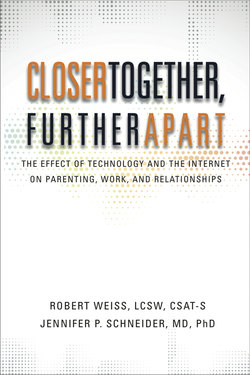Читать книгу Closer Together, Further Apart: The Effect of Technology and the Internet on Parenting, Work, and Relationships - Jennifer Schneider - Страница 14
На сайте Литреса книга снята с продажи.
Talkin’ ’Bout My Generation ...
ОглавлениеBeyond the obvious age differences, “generations” are typically defined by their use of slang; their choice of music and clothing; and their politics, social causes, and technological influences.
| The “Digital Immigrant” Generations, Born 1901–1982 | |
| Generation | Dates Born |
| Greatest Generation | 1901–1924 |
| Silent Generation | 1925–1945 |
| Baby Boomer | 1946–1964 |
| Generation X | 1965–1982 |
The Greatest Generation and the Silent Generation were the children and young adults of the Depression. They either fought in or supported the troops in World War II. These people experienced the advent of blues and jazz, listening to that music on newly evolving technologies like phonographs and radios. They were born into a world without television or microwave ovens. The formative moments in their lives were the Titanic disaster in 1912, Charles Lindbergh’s transatlantic flight in 1927, the stock market crash of 1929, the Great Depression, and World Wars I and II. These were the first generations to ride in automobiles, the first to have universal access to electricity and fully plumbed homes, and the first to be able to communicate in real time via telephone.
Those in the Baby Boomer generation were born during the post-WWII “baby boom.” In their youth, they were typically associated with a rejection of the more traditional or “conservative” values of their parents. They are credited with generating both social upheaval and liberal change in the United States and throughout the Western world, resulting in a liberal versus conservative political and cultural divide that lives on to this day. Baby boomers listened to Elvis, the Beatles, and Motown on transistor radios and 45 rpm records. They grew up glued to television, enthralled by the Ed Sullivan Show, the Brady Bunch, Gilligan’s Island, the Twilight Zone, and, of course, the Wonderful World of Disney. Early baby boomers (born 1946–1955) list the Cuban Missile Crisis; the assassinations of John F. Kennedy, Robert Kennedy, and Martin Luther King; the first moon landing; Roe versus Wade; the Vietnam war; Woodstock; and the civil rights, women’s rights, and gay rights movements as formative events in their lives. Later boomers (born 1956–1964) were more conscious of Watergate, the Iran hostage crisis, raging inflation, gasoline shortages, and, of course, disco.2
Generation X (Gen X) includes people born between 1965 and 1982. They are often characterized as a “slacker” generation, though studies show their values and work ethic are not so different from those of their parents. This generation listened to pop, punk, alternative, rap, and hip hop music on their boom boxes and Sony Walkmans. Their lives were shaped by the 1973 oil crisis and subsequent years of worldwide financial recession, the 1986 Chernobyl disaster, the 1989 fall of the Berlin Wall, and the end of the Cold War. They played Donkey Kong and Mario Bros on increasingly sophisticated video gaming platforms. They experienced the earliest days of cable TV and were particularly influenced by Sesame Street and Music Television (MTV), the first network aimed specifically at them as a demographic. Gen Xers were also profoundly influenced by the AIDS epidemic, crack cocaine, and designer drug abuse. Some Gen Xers did not use personal computers and the Internet until early adulthood, while others had these technologies available to them earlier.
| The “Digital Native” Generations, Born 1983 to Now | |
| Generation | Dates Born |
| Generation Y | 1983–2000 |
| Generation Z | 2001–present |
Generation Y (Gen Y), also known as “Millennials,” are more familiar with interactive communication, media, and digital technologies than prior generations. Gen Ys listen to hip hop, rap, indie (independent), post-grunge, electronic, techno, dubstep, R&B (rhythm and blues), rock, hardcore punk, metalcore, teen pop, pop punk, Eurodance, K-pop (Korean pop), C-pop (Chinese pop), J-pop (Japanese pop), Bhangra, and international music on iPods and other MP3 devices. They get their news online rather than reading a newspaper or watching the evening news. Gen Y is sometimes accused of suffering from “Peter Pan Syndrome,” delaying rites of passage into adulthood (such as getting a job and moving out of the house).3 Defining moments for Gen Ys include the tragedy of 9/11, the wars in Iraq and Afghanistan, the arrival of social media (Facebook and MySpace), the smartphone, the 2007–2008 global financial crisis, and the election of Barack Obama as United States president. However, the single most defining characteristic of Gen Y is that its members use digital technology as a primary resource for communication, interaction, and information gathering. They do so more often, more fluidly, and for far more purposes than previous generations.
Generation Z (Gen Z), also known as the “Always On” generation, have never known a world without modern high-speed Internet. Engaging with each other via social media is as natural to Gen Zs as breathing. They were born into a world of multitasking. The neurobiological, developmental, social, and educational impact of this way of living from birth onward is as yet unknown. In many ways, much like the baby boomers of yore, Gen Z is a true social experiment in the making because we really don’t know what Gen Zs will look like in the future or how they will meet, work, or mate.
